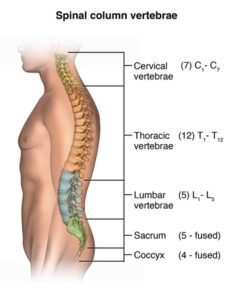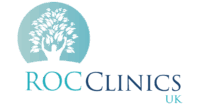
We all get back pain from time to time but what do we know about the back and how to look after it?
When we think of the back naturally, we think of the spine. This is the big column of bone and cartilage that runs from your bottom to the base of your skull. The spine is made up of 33 bones called vertebra.
Knowing your spine and how it works can help you recognize some of the difficulties that occur due to injury or getting older.
We expect our spine to do a lot of work. Not only does it support your head, shoulders, and your torso, but it is flexible allowing you to twist and bend. The spine helps to protect the spinal cord and supports you to stand up straight.
The Backbone Breakdown: Exploring the Five Sections of the Spine
When we speak about the spine, we refer to it as being five distinct sections constructed of vertebra, forming a column protecting the spinal cord.

The cervical vertebra – consisting of seven vertebrae (bones)
The thoracic vertebra – consisting of twelve vertebrae.
The lumbar vertebra – consisting of five.
The sacral vertebra- consisting of five vertebrae.
The coccygeal vertebra – consisting of four vertebrae.
Supporting the Support System: Ligaments, Muscles, and Connective Tissues
Each vertebra has a cushion or disc between it and the spinal column is supported by a network of muscle and connective tissue. Ligaments, the tough, flexible bands of connective tissue, connect the vertebrae to hold the spine in position. Muscles (both superficial and deep) support the back, help with movement, and assist with breathing. Tendons join muscles to bone and aid movement. The entire back and spinal column are supported by a network of arteries, veins, and nerves.
Navigating the Vulnerable Lumbar Region: Insights into Common Back Injuries
The most common injury affecting the back is lumbar (lower back) strains and sprains. This is due to the lumbar region having to support substantial forces, including the weight of the body, the weight of any outer items and bursts of speed/movement of body and limbs.
As you can see in the diagram this is the part of the spine which joins the upper and lower parts of the body and this area is vulnerable as it does not have the support of bone, such as rib or pelvis and any force applied must be transferred via this route.
Back Care 101: Simple Steps to Keep Your Spine Strong and Healthy
So, how do you care for your back?
One of the easiest ways to avoid back pain is to maintain strong muscles in your back and abdomen. Try to do stretching and strengthening exercises as often as you can.
Always be aware of your posture, slouching and leaning forward can cause aches and pains, so stand and sit up straight. If you are sitting at work for hours a day, ensure you have an ergonomic assessment of your workstation done. You can do a self-assessment online through the HSE website.
Always make sure you are lifting and carrying items properly. Make sure your leg muscles are doing the work when you are lifting heavy loads: bend your knees and keep your back straight, and hold items close to your body. If you are given manual handling training, make sure you follow the rules you are taught and always ask for help if you feel an item is too heavy.
Stay active and eat healthily. Try to keep your weight within a healthy limit as being overweight puts strain on your back. Even gentle exercise such as walking can help you maintain your weight.
Back Pain and the Workplace: A Costly Challenge for Employers
Currently back pain is one of the leading reported causes for sickness absenteeism in the UK. Statistics suggest that absence due to back pain costs employers over £12 billion annually.
The employer has a duty of care to the employee to ensure the pain is not being caused by work activities and to help the employee return to work as soon as able.
ROC Health Group: Your Partner in Occupational Health and Back Pain Management
ROC Health Group Ltd can help with this by offering an expert Occupational Health team to arrange and manage your absence management needs. We will work with your business to establish procedures to promote early reporting of back pain/issues, prompt assessment of the back pain and provide appropriate advice about adjustments and recommendations to ensure the injury or illness is not being caused or exacerbated by work.
Our dedicated, professional staff will ensure your company is compliant with the relevant legislation, offer recommendations about ergonomics in the workplace, and will supply pertinent, up to date health promotion to your employees, helping them to understand the importance of selfcare and encourage active participation in programmes and surveillance provided by the Company via Occupational Health.
To enquire further please get in touch.
